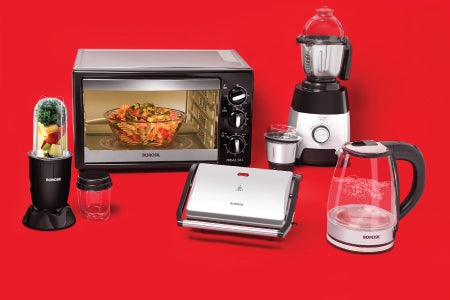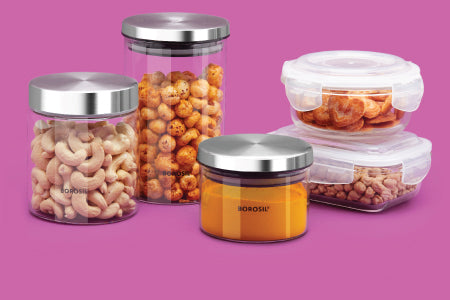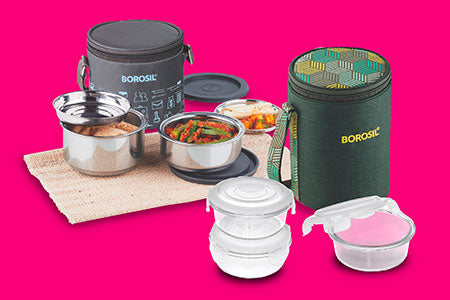
Best Methods To Clean Gas Stove Burners
Learn How to Clean Stove Burner: Restore Its Spotless State
Gas stoves are the go-to choice for many Indian families. With their quick and efficient heat control, they make cooking a breeze. Just like other kitchen appliances like woks, saucepans, mixing bowls, etc, gas stove burners also require an equal amount of maintenance.
Ever noticed those greasy, yellow stains on your burner? They can build up on the tiny holes that distribute the flame, making your stove less efficient and your cooking experience less enjoyable. That's why it's crucial to know how to clean a gas burner.
In this fun and easy guide, we'll show you how to clean gas stove burners easily at home using simple ingredients you probably already have in your kitchen. Let's dive in and make your stove shine like new!
What is a Gas Stove Burner?
A gas stove burner is a kind of kitchen stove that utilises combustible gas, liquefied petroleum gas, propane, butane or some other flammable gas to produce a flame for cooking dishes. The best part about a stove burner is that it allows you to visually witness the increase and decrease of temperature whenever you turn the knob of the gas stove. Additionally, you can take advantage of cooking over the fire by directly heating your favourite chillies or chapatis on the burner.
A gas burner incorporates a gas intake valve that gets attached to the main gas line. When you turn the dial or switch on the knob, the intake valve opens up, providing a route for convenient gas flow. Plus, the standing pilot light sends a signal in the form of a spark or small flame to illuminate the air-gas combination, which passes through the tiny holes of the burner. During this ignition and cooking process, the burner head might get clogged up because of food residue and must be cleaned up to ensure its proper functioning. 
How Do You Clean a Gas Burner? Know the Simple Process!
Now that you have understood how a gas stove works let us go through the simple steps to clean this essential kitchen tool. The following method uses ingredients that are already present in everyone's household- vinegar and baking soda. These are natural cleaning elements that will help you effectively remove the deposited food residue and grease completely from the surface. So, if you are wondering how you clean gas stove burners, follow these below-mentioned steps:
Step 1: Remove the Burner Caps and Heads
Start the cleaning process by removing the ceramic discs placed over the burner. All you have to do is simply lift the disc from the gas burner to wash off the dirt. When done, lift the burner heads. These sit above the gas tube. Make sure that the burners are not hot when you conduct this removal step to avoid any potential harm.
Step 2: Soak & Dip the Parts
Now, make a mixture using baking soda and water in a large container. Add equal amounts of both liquids to achieve a perfect solution for soaking the burner and its parts. Dip the stove burner caps and heads into the mixture. Let these parts entirely soak in the container for a long duration, let's say approximately 30 minutes, to loosen the gathered dirt and debris.
Step 3: Make a Paste
Take out the burner, caps and all the parts. Add a few tablespoons of baking soda in a bowl and then a few drops of water to form a thick paste. Apply this mixture on the surface of the parts and let it stay for at least 15 minutes.
Step 4: Scrub Away the Dirt
Grab a non-abrasive scrub along with an old toothbrush to cleanse away the grease and stains from the burner caps and heads. Pay careful attention to the sides, bottom and back of the parts to restore their shine. Remember not to use a toothpick to draw out dirt from the holes as it might clog up the ports, resulting in further damage.
Step 5: Rinse the Parts
After cleaning the burner and its caps, rinse them thoroughly under running high-intensity water. Shake the parts to get rid of excess water, and then take any cloth to dry them out. It is suggested that you leave the gas stove parts in fresh air, giving them some time to dry out naturally before assembling them back.
Step 6: Reassemble
Once all the parts are fully dried out, you can reassemble them, back to their designated place. Be careful during this process, to not provide any harm to the burner. Also, wipe out the knobs for a cleaner and better appearance and function of the stove.
In a Nutshell
If you do not wish to see greasy splatters piled up on your kitchen's staple item, gas stovetop, then consider the above-mentioned steps on how to clean burners on a gas stove using baking soda and vinegar. Conduct this deep cleansing process at least twice a month to avoid overuse of LPG that can happen due to accumulated dirt and clogged-up pores. These quick, easy steps will ensure the long-lasting functionality of the gas stove, letting you cook all your favourite food items with ease and convenience.
FAQs
How often should I clean the gas burners?
The frequency of the cleaning process broadly depends upon your usage of the gas stove. The more the usage, the more the chances of the burner getting dirty and the more the maintenance requirement. One thing that you should keep in mind is if the flame gets irregular or starts changing its colour into a yellowish hue, then it's your sign to deeply clean the burner and its parts.
What type of homemade cleaner is effective for gas stove burners?
If you are looking for the safest and most effective homemade cleaner for your gas stove, then you can try vinegar and baking soda, the natural cleaning agents for making the parts of the stove look brand new.
Is it mandatory to call for outside help to clean my gas stove burner?
Cleaning at home using household staples is enough to clean your gas stove burner. However, if your burner isn't working properly even after the deep maintenance process, then you should reach out for outside professional help to discover the technical difficulty that might arise due to clogged-up pores of the burners.





















